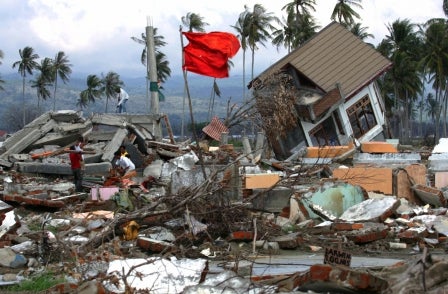
In 1984, television news characterised the famine in Ethiopia as a sudden and urgent catastrophe.
It was reported as a (sudden) event rather than a very slow process. Yet starvation is never an immediate disaster, like an earthquake. It happens very slowly over months if not years. This was the message that some of the aid agencies had been trying to convey throughout 1983. They were trying without success to draw attention to a gradual process where conditions were slowly becoming worse.
In general earthquakes, landslides and sudden disasters, which are events that kill a number of people quickly, get more media attention and relief than those crises that kill people slowly. This depiction of disasters fits closely with the wider definitions of what makes news.
Most natural disasters like earthquakes or volcanoes display many of these key characteristics that are classically associated with news values. They are something that is sudden, unexpected, dramatic, negative and unambiguous.
This is why disasters, even though they occur in faraway places, are often highly newsworthy events, provided there is sufficient media access.
The Asian Tsunami on 26 December 2004 was a perfect example of this. It was perceived as the ultimate act of nature, where no one was to blame.
This, combined with direct Western involvement in the tragedy (tourists on the beaches) and the proximity to Christmas, generated a fast and generous response.
As the donations flowed in early 2005, in response to the media reporting of the Tsunami, there were continual comparisons with the problems of Africa. Every year far more people die in Africa from disease and starvation than were killed in the Tsunami, but it is a continual and hidden‚ problem without the sudden drama of the Tsunami.
The chronic and continuing nature of Africa's problems make them susceptible to compassion fatigue.
The Commission for Africa report in 2005 referred to a Tsunami every month in Africa. But its deadly tide of disease and hunger steals silently and secretly across the continent. It isnot dramatic and its victims rarely make the television news.
The Asian Tsunami fulfilled a high proportion of the key criteria for news values apparent in disasters because it was sudden, unexpected, dramatic, negative and unambiguous. It was a classic case of a sudden disaster killing people, quickly attracting far more relief than a chronic and less visible crisis that grinds people down slowly. The Tsunami also had one extra factor, which was the involvement of elites.
Typically natural disasters occur in poor countries, which might detract from their newsworthiness, but the Tsunami involved a number of Western tourists which gave it an additional dimension. And in many cases, because there were nationals involved, it became a domestic rather than just a foreign story. It is therefore unsurprising that the areas which involved Western tourists, in particular Thailand and Sri Lanka, received far more media attention than those which did not˜specifically those parts of Indonesia such as Banda Aceh which were by far the worst affected and
had the highest death toll.
So there is no relation between the level of coverage and the number of deaths. Instead the presence of Westerners and Western deaths is related to the volume of media stories.
Tsunami death toll
Dead/Missing/Number of Stories
- Indonesia: 167,000/343
- Sri Lanka: 35,000/729
- Thailand: 8,200/771
Source: UN Office of the Special Envoy for Tsunami Recovery/analysis of Lexis Nexis stories.
In general sudden disasters, once they are known about, will sustain significant media attention, at least for a while, and this helps to generate a humanitarian response, although there are still exceptions.
Famine, on the other hand, can never be a sudden event. It is generally a chronic, creeping process that can be complicated to explain. This generally gives it a far lower ranking on the accepted scale of newsworthiness.
Yet in 1984 the characterization of famine as a sudden, urgent problem was significant in the way that it gained major exposure and attention. The Michael Buerk news item which went round the world highlighted the discovery‚ of a famine.
Christopher Bosso in his analysis of the impact of the media coverage of the famine makes much of the way it was presented as a sudden discovery. The perception of famine as an act of nature due to failing rains was also important in the scale and generosity of the response in 1984.
The distinction between natural disasters (good causes) and man-made disasters (more dubious and complicated causes) prevailed in public perceptions. It had a significant effect on the way the public responded to appeals, because the way in which disasters are characterised within the media is of key importance in fund raising.
This guest blog is an extract from Reporting Disasters – Famine, Aid, Politics and the Media by Suzanne Franks who is a professor of journalism at City University in London. The book is published by Hurst and Company.
Email pged@pressgazette.co.uk to point out mistakes, provide story tips or send in a letter for publication on our "Letters Page" blog
